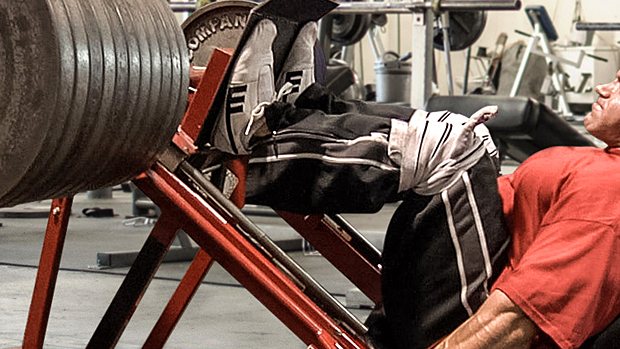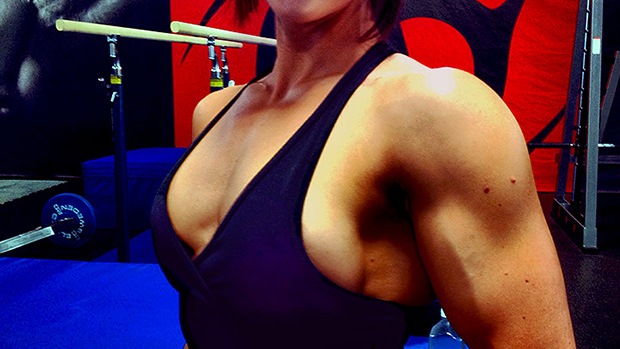One of the bummers associated with body-comp training is the concurrent loss of muscle, and therefore, strength. And while this outcome is partly dictated by physiology, it's also partly the fault of uninspired program design.
Typically, trainees engaging in "cutting" phases tend to ignore strength maintenance/development. There's really no logical reason for this error other than the fact that sometimes we all need an education in the obvious, and that's what this article's all about.
Now of course, some loss in lean-body mass is inevitable while dieting and/or pursuing body-composition training. However, it really is possible to maintain, and in some cases, even increase strength levels while stripping off unwanted body fat. One such creative solution to this problem is offered by a variant of Escalating Density Training which uses convergent phase cycling.
In essence, what we'll do is to position high-efficiency maximal strength loading sessions immediately prior to higher-volume training, which creates an intense demand on the metabolic and endocrine systems, thus triggering fat oxidation and muscular hypertrophy.
Later on, during a "mass" cycle, the strength you maintained will serve you well as you hit the weights hard and heavy.
Okay, enough of the introduction and self-indulgent sales-schtick for my (admittedly) super-cool training program. Let's get to the meat and potatoes.
Training frequency is three times per microcycle. In the example I provide here, a microcycle is one week. This may not exactly wet the palate of those of you who rely on their gym time for cross-gender observational analysis, but I'll assume that your training goals supersede your social needs for now.
Each workout consists of a "core" exercise, and a circuit. You'll use three core exercises and two circuits. It's actually pretty simple:
You'll select three multi-joint exercises that represent a large percentage of the body's total muscle mass with minimal redundancy. These will consitute your core exercises. One example might be the squat, pull-up and bench press. Another might be the deadlift, dips, and rows. In the example below, I use hang cleans, squats, and bench presses. You get the drift. (By the way, choose exercises that you can perform safely – this program can get pretty intense.) In addition to your three core exercises, you'll need to alternate between the following circuits.
Each circuit represents approximately half of the body's muscles. I designated muscle groups into the following two circuits (kind of like making two "piles" of muscle groups):
"A" Circuit
- Hamstrings
- Lats / Traps/ Rear Delts
- Triceps
- Gastrocs
- Rectus Abdominus / Trunk-Hip Flexion
- Grip Strength (Wrist and / or finger flexion emphasis)
"B" Circuit
- Quads
- Pecs / Front Delts
- Biceps / Brachialis / Brachioradialis
- Soleus
- Obliques / Flexion-rotation exercises
- Grip Strength (Wrist and / or finger extension emphasis)
When choosing the exact circuit exercises to use, base your choices on eliminating weaknesses. For example, if your squats seem to be limited by poor low back strength, choose exercises that will be instrumental in addressing that weak link. If you're an athlete and/or physical performance is important, lean toward free weight exercises. If body comp is your only goal, machines are an acceptable choice. (I'll provide examples below in case you don't want to spend time figuring out which exercises to use in your circuits.)
The name "convergent phase training" (CPT) refers to the fact that there are two separate rhythms (or "phases") that converge on regular intervals – in this case, every two weeks. Here's a skeleton outline of the first two microcycles for the example I've provided here:
Week One
| Day | Core | Circuit |
|---|---|---|
| Monday | Clean | A |
| Wednesday | Bench | B |
| Friday | Squat | A |
Week Two
| Day | Core | Circuit |
|---|---|---|
| Monday | Clean | B |
| Wednesday | Bench | A |
| Friday | Squat | B |
As you can see, what's cool about this cycle is that you'll train for a full two weeks without ever repeating the same workout. Yet at the same time, there is a significant amount of continuity, which is critical for strength maintenance.
Loading Parameters For Core Exercises: First perform 4-6 sets of 2-3 reps of your chosen core exercise, whether it be squats, deadlifts, pullovers, etc., using progressively heavier weights, until you reach 80% to 90% of your current 1RM for the exercise. This process should take 10-12 minutes depending on the exercise and how strong you are.
Next, set your stopwatch for 15 minutes and perform 10 singles of that same core exercise with your chosen working weight in the 15-minute PR (personal record) Zone. Rest only as long as absolutely necessary. Each time you repeat the same workout, try to beat the total number of singles you can achieve in the 15 Minute PR Zone. If you manage 12 or more reps in 15 minutes, increase the load by 5 percent the next time you repeat that workout and start over.
Just to be sure I made myself clear, I'll run that by you again. For your core exercises, whether they be bench presses, cleans, or squats, you'll begin by doing 4-6 sets of 2-3 reps. Then, you'll set a timer or stopwatch for 15 minutes. As it counts down, you'll do singles of that same core exercise. You'll do one rep, rest, and then do another until the timer starts beeping. If you've got enough gas to do 12 or more single reps in that 15 minute stretch, increase the weight by about 5% the next time around.
For those not yet familiar with EDT's unique loading parameters, here are the nuts and bolts:
- Escalating Density Training is based on the concept of doing more and more work from workout to workout. Therefore, it's critical that your exercise biomechanics (i.e., technique) is consistent on every workout. If you perform strict curls on one workout and loose form the next, you aren't really doing more work (for the arms at least!).
- I recommend 10-15 minutes of light to moderate cardio, followed by 10-15 minutes of light stretching on "off" days for the purpose of promoting active recovery and reducing soreness.
- Each workout in this cycle consists of (3) PR Zones of 15-minutes duration separated by a short (5-minute) rest periods. In each PR Zone, you'll generally perform two exercises, for a total of 3-4 exercises per workout.
- In each PR Zone, you'll typically perform two antagonistic exercises in alternating fashion, back and forth, using the same weight for all sets, until the PR Zone has elapsed.
- After warming up the first exercise(s), select a load that approximates a 10 RM for each exercise. Ideally, the weight used for each exercise should be equally difficult.
- Sets/Reps/Rest Intervals: This is where EDT is truly unique. Most people will find it most productive to do higher repetition (but not maximal effort) sets and shorter rests at the beginning, and then gradually progress to fewer reps per set and longer rest intervals as fatigue accumulates. As an example, you might begin by performing sets of 5 with very short (10-15 second) rests. As you begin to fatigue, you'll increase your rest intervals as you drop down to sets of 4, then 2, and as the time limit approaches, you might crank out a few singles in an effort of accomplish as many repetitions as possible in the time allotted.
- Note: Do not perform early sets to failure, or even near failure. My recommended starting point is to do 1/2 of what is possible (e.g., 5 reps with a 10RM weight) at the beginning of the time frame. As the time limit approaches however, you'll find yourself working at or near failure as you attempt to break your rep record.
- Progression: Each time you repeat the workout; your objective is to simply perform more total repetitions in the same time frame. As soon as you can increase the total number of reps by 20 percent or more, start the next workout with 5 percent more weight and start over. Similarly, if you manage to improve upon your last performance (for the same workout) by 40 percent, then you'll increase your weights by 10 percent on the next workout.
(And Believe Me, This Hurts Me More Than It Does You!)
Week One
Monday
- A. Core Movement: Hang Clean
- B. "A" Circuit
First PR Zone (15 Minutes)
- (Hamstrings): Glute-Ham-Gastroc Raise, Back Extension, or Reverse Hyper (choose one)
- (Lats): Chin-up, Pull-up, Or T-Bar Row (choose one). Rest: 5 minutes

Second PR Zone (15 Minutes)
- (Triceps): Lying Dumbbell or EZ-Bar Triceps Extension (choose one)
- (Gastrocs): Jumps in Place (use dumbbells for added resistance). Rest: 5 Minutes
Third PR Zone (15 Minutes)
- (Rectus Abdominus): Hanging Pikes or Prone Ball Rolls (choose one)
- (Grip Strength): Straight Bar or EZ-Bar Reverse Curl (choose one)


Wednesday
- A. Core Movement: Bench Press
- B. "B" Circuit
First PR Zone (15 Minutes)
- (Quads): Decline Step-up (Right)
- (Quads): Decline Step-up (Left). Rest: 5 Minutes

Second PR Zone (15 Minutes)
- (Pecs): Incline Dumbbell Press
- (Biceps): Dumbbell Preacher Curl. Rest: 5 Minutes
Third PR Zone (15 Minutes)
- (Soleus): Seated Calf Raise
- (Obliques): Russian Twist

Friday
- A. Core Movement: Squat
- B. "A" Circuit
First PR Zone (15 Minutes)
- (Hamstrings): Glute-Ham-Gastroc Raise, Back Extension, or Reverse Hyper (choose one)
- (Lats): Chin-up, Pull-up, Or T-Bar Row (choose one). Rest: 5 minutes
Second PR Zone (15 Minutes)
- (Triceps): Lying Dumbbell or EZ-Bar Triceps Extension (choose one)
- (Gastrocs): Jumps in Place (use dumbbells for added resistance). Rest: 5 Minutes
Third PR Zone (15 Minutes)
- (Rectus Abdominus): Hanging Pikes or Prone Ball Rolls
- (Grip Strength): Straight Bar or EZ-Bar Reverse Curl
Week Two
Monday
- A. Core Movement: Hang Clean
- B. "B" Circuit
First PR Zone (15 Minutes)
- (Quads): Decline Step-up (Right)
- (Quads): Decline Step-up (Left). Rest: 5 Minutes
Second PR Zone (15 Minutes)
- (Pecs): Incline Dumbbell Press
- (Biceps): Dumbbell Preacher Curl. Rest: 5 Minutes
Third PR Zone (15 Minutes)
- (Soleus): Seated Calf Raise
- (Obliques): Russian Twist
Wednesday
- A. Core Movement: Bench Press
- B. "A" Circuit
First PR Zone (15 Minutes)
- (Hamstrings): Glute-Ham-Gastroc Raise, Back Extension, or Reverse Hyper (choose one)
- (Lats): Chin-up, Pull-up, Or T-Bar Row (choose one)
Second PR Zone (15 Minutes)
- (Triceps): Lying Dumbbell or EZ-Bar Triceps Extension (choose one)
- (Gastrocs): Jumps in Place (use dumbbells for added resistance). Rest: 5 Minutes
Third PR Zone (15 Minutes)
- (Rectus Abdominus): Hanging Pikes or Prone Ball Rolls
- (Grip Strength): Straight Bar or EZ-Bar Reverse Curl
Friday
- A. Core Movement: Squat
- B. "B" Circuit
First PR Zone (15 Minutes)
- (Quads): Decline Step-up (Right)
- (Quads): Decline Step-up (Left). Rest: 5 Minutes
Second PR Zone (15 Minutes)
- (Pecs): Incline Dumbbell Press
- (Biceps): Dumbbell Preacher Curl. Rest: 5 Minutes
Third PR Zone (15 Minutes)
- (Soleus): Seated Calf Raise
- (Obliques): Russian Twist
Week Three
Monday
- A. Core Movement: Hang Clean
- B. "A" Circuit
First PR Zone (15 Minutes)
- (Hamstrings): Glute-Ham-Gastroc Raise, Back Extension, or Reverse Hyper (choose one)
- (Lats): Chin-up, Pull-up, Or T-Bar Row (choose one). Rest: 5 Minutes
Second PR Zone (15 Minutes)
- (Triceps): Lying Dumbbell or EZ-Bar Triceps Extension (choose one)
- (Gastrocs): Jumps in Place (use dumbbells for added resistance). Rest: 5 Minutes
Third PR Zone (15 Minutes)
- (Rectus Abdominus): Hanging Pikes or Prone Ball Rolls (choose one)
- (Grip Strength): Straight Bar or EZ-Bar Reverse Curl (chooseone)
Wednesday
- A. Core Movement: Bench Press
- B. "B" Circuit
First PR Zone (15 Minutes)
- (Quads): Decline Step-up (Right)
- (Quads): Decline Step-up (Left). Rest: 5 Minutes
Second PR Zone (15 Minutes)
- (Pecs): Incline Dumbbell Press
- (Biceps): Dumbbell Preacher Curl. Rest: 5 Minutes
Third PR Zone (15 Minutes)
- (Soleus): Seated Calf Raise
- (Obliques): Russian Twist
Friday
- A. Core Movement: Squat
- B. "A" Circuit
First PR Zone (15 Minutes)
- (Hamstrings): Glute-Ham-Gastroc Raise, Back Extension, or Reverse Hyper (choose one)
- (Lats): Chin-up, Pull-up, Or T-Bar Row (choose one). Rest: 5 Minutes
Second PR Zone (15 Minutes)
- (Triceps): Lying Dumbbell or EZ-Bar Triceps Extension (choose one)
- (Gastrocs): Jumps in Place (use dumbbells for added resistance). Rest: 5 Minutes
Third PR Zone (15 Minutes)
- (Rectus Abdominus): Hanging Pikes or Prone Ball Rolls (choose one)
- (Grip Strength): Straight Bar or EZ-Bar Reverse Curl (choose one)
Week Four
Monday
- A. Core Movement: Hang Clean
- B. "B" Circuit
First PR Zone (15 Minutes)
- (Quads): Decline Step-up (Right)
- (Quads): Decline Step-up (Left). Rest: 5 Minutes
Second PR Zone (15 Minutes)
- (Pecs): Incline Dumbbell Press
- (Biceps): Dumbbell Preacher Curl. Rest: 5 Minutes
Third PR Zone (15 Minutes)
- (Soleus): Seated Calf Raise
- (Obliques): Russian Twist
Wednesday
- A. Core Movement: Bench Press
- B. "A" Circuit
First PR Zone (15 Minutes)
- (Hamstrings): Glute-Ham-Gastroc Raise, Back Extension, or Reverse Hyper (choose one)
- (Lats): Chin-up, Pull-up, Or T-Bar Row (choose one). Rest: 5 Minutes
Second PR Zone (15 Minutes)
- (Triceps): Lying Dumbbell or EZ-Bar Triceps Extension (choose one)
- (Gastrocs): Jumps in Place (use dumbbells for added resistance). Rest: 5 Minutes
Third PR Zone (15 Minutes)
- (Rectus Abdominus): Hanging Pikes or Prone Ball Rolls (choose one)
- (Grip Strength): Straight Bar or EZ-Bar Reverse Curl (choose one)
Friday
- A. Core Movement: Squat
- B. "B" Circuit
First PR Zone (15 Minutes)
- (Quads): Decline Step-up (Right)
- (Quads): Decline Step-up (Left). Rest: 5 Minutes
Second PR Zone (15 Minutes)
- (Pecs): Incline Dumbbell Press
- (Biceps): Dumbbell Preacher Curl. Rest: 5 Minutes
Third PR Zone (15 Minutes)
- (Soleus): Seated Calf Raise
- (Obliques): Russian Twist
If you make it this far, I guarantee you'll meet the new year with a decidedly new and improved body! Keep in mind that the exercises I provided, while logical, are rather arbitrary. Feel free to substitute like movements as you please.
Now let's burn the fat and keep the muscle!





